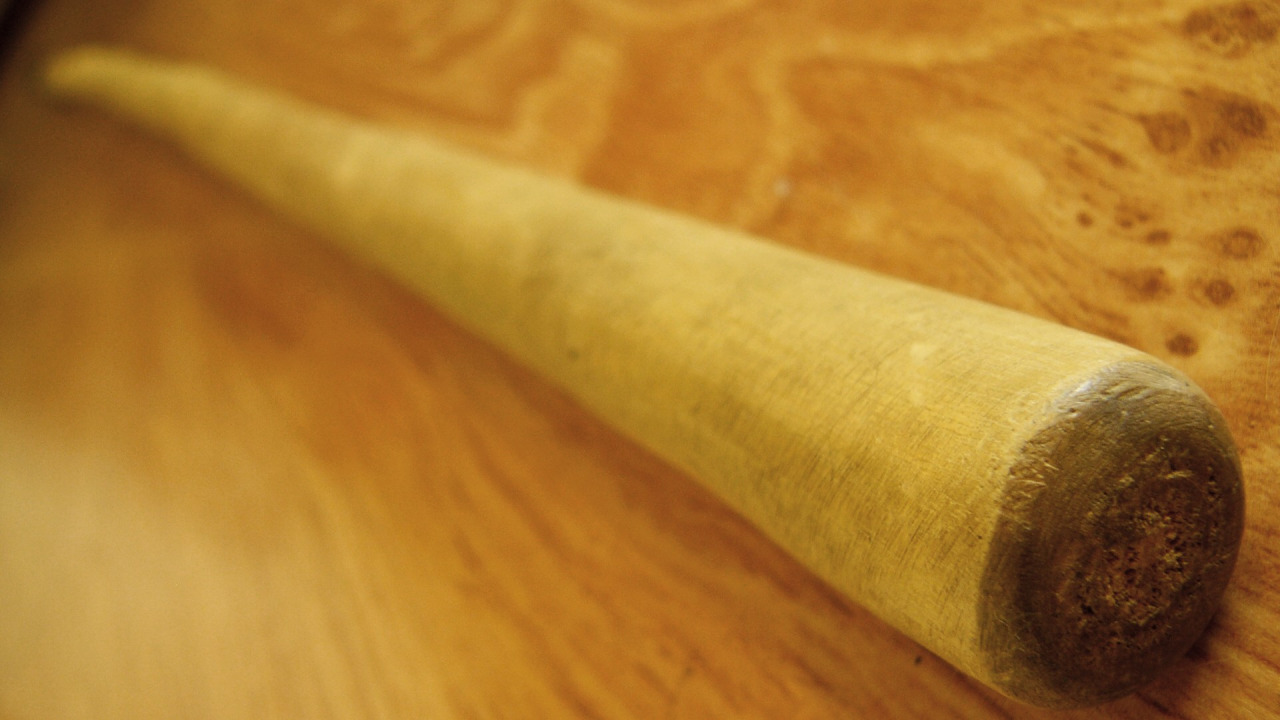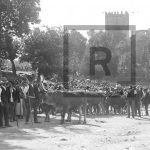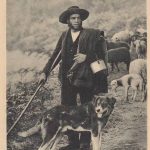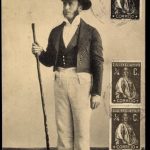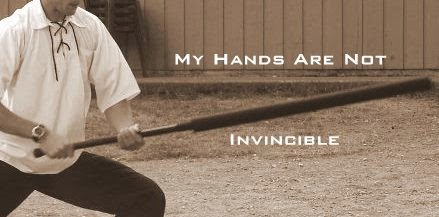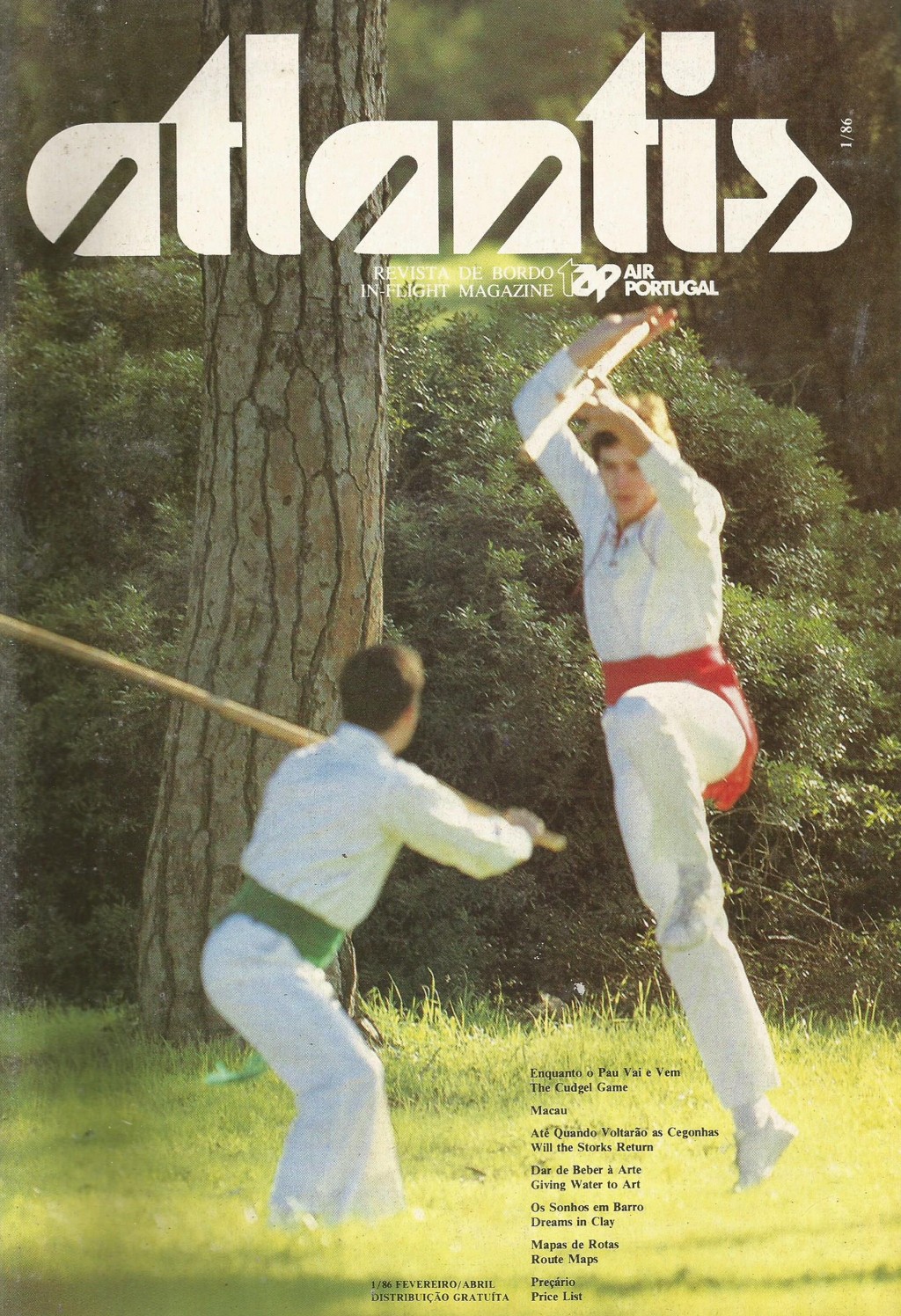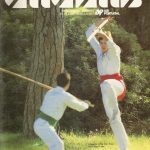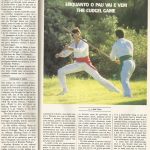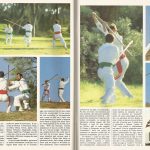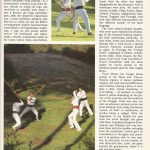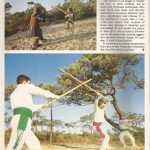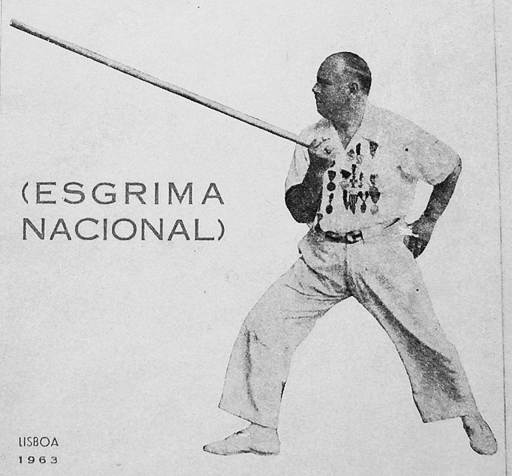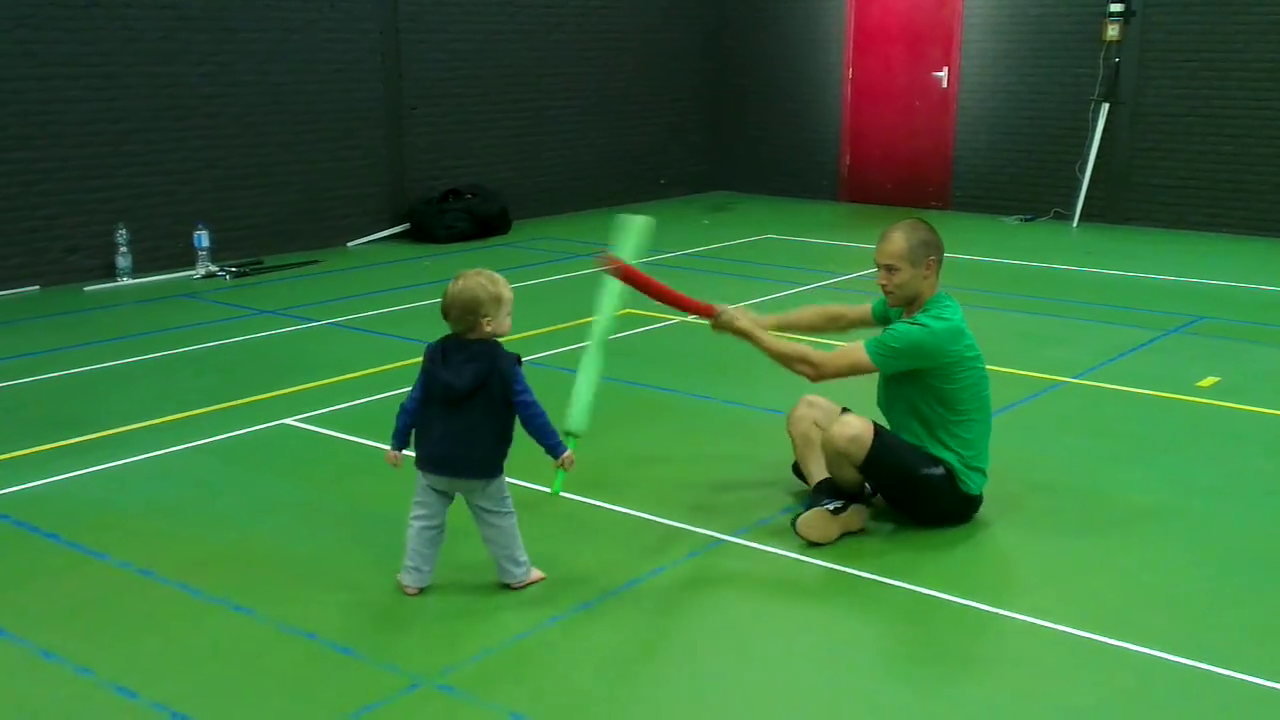Extensive interview with master Nuno Russo on his life as a martial artist and his progress and work on jogo do pau.
in English
Posts that are in English or have a translation (usually in the bottom).
-Also images and videos with English description. but not all images.
Manuel Cid – Distinto mestre de armas e jogador de pau
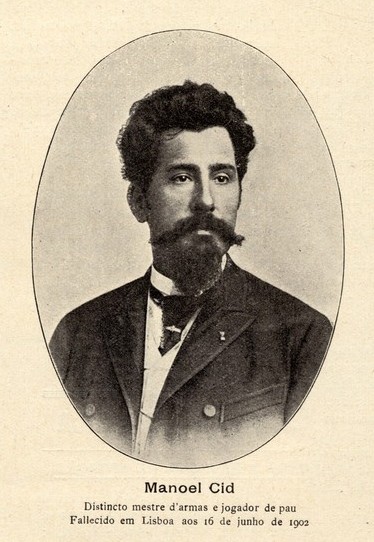
Manuel Cid, além do seu conhecido trabalho como mestre de armas, ensinava também a esgrima de pau, chegando a realizar assaltos de pau em conjunto com os das outras armas da esgrima em demonstrações publicas, inclusive no estrangeiro. Foi também professor de jogo do pau de Isidoro Correia Gomes, segundo mestre do Ateneu Comercial de Lisboa.
- “O Tiro Civil” nº 238 – 1902
- “Diário Ilustrado” – 2 de Maio de 1891
- “Jogo do pau (Esgrima Nacional)” – António Nunes Caçador, 1963
-
“Diário Ilustrado” – 29 de Novembro de 1891
” Academia de estudos Livres – todas as segundas quartas e sextas feiras o sr. M. Cid ensina a esgrima do florete, sabre e pau, na academia d’armas.”
- “Diário Ilustrado” – 2 de Maio de 1889
Manuel Cid chegou do estrangeiro, o estimado professor d’armas dos corpos de guarnição de Lisboa (…) O sr. Cid foi a França, por convite particular, assistir a um congresso de esgrimistas. O sr. Manuel Cid viu o que havia de melhor nas escolas francezas de esgrima, civis e militares, tendo occasião de se fazer applaudir nos seus exercicios de sabre, florete, e pau. O Journal da “l’Academie d’Armes” registou os méritos do sr. Cid. - “L’Escrime Française” – 12 Juilliet 1902
Nous apprenons la mort du maître d’arme portugais Manuel Cid(…) Il etait haut, 1m. 87, brun, grande chevelure et barbiche noire. Bâti en athlète, possédant une force bien travaillée. Très connu ici et très estimé. Chasseur enragé, il était aussi professeur de bâton qu’il maniait avec une vraie connaissance et une supériorité écrasante.
EN: Fencing master Manuel Cid, died in 1902, he used to teach fencing classes alongside jogo do pau, in the “Academia de Estudos Livres” he taught foil, saber and staff fencing, and did public exhibitions of fencing including assaults of jogo do pau, including one in France in 1889.
The Walking Staff in length
The walking staff
The staff as a weapon is seen in many martial arts all around the world, but being it such a simple weapon, a variation in its length can affect the way is it used in combat.
The staff in the Portuguese tradition is a walking staff, and a common “tool” in the rural areas, to drive the cattle, walk, etc, Its length emerges naturally from this functions, because, if it was much longer, it wouldn’t be as easy to maneuver when walking, and if it was much shorter, it could help on walking as a walking cane, but would not give support as a Shepherd need from his staff.
In other contexts we can see longer staffs, for example, the campinos from Ribatejo use much longer staffs, but they use it to herd cattle from the horseback, so they naturally need a longer staff.
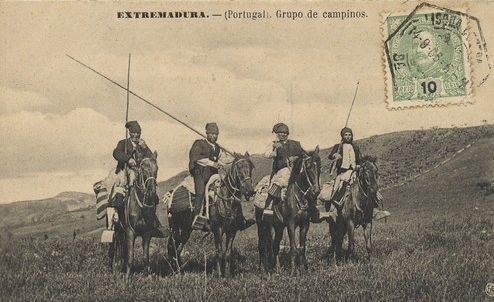
Prior to any standardization, the staff of jogo do pau would vary in length, but would always be kept within certain limits, usually longer than a walking cane, and never much taller than a man.
It was however, not a weapon, this staff length, was not choose for it excellence in combat, it emerged naturally, but besides its practical application in other function, it somehow has also characteristics that made it ideal in length for the context in which jogo do pau developed.
Alternative weapons
Staff fencing in Portugal had great relevance at a time when there were no other forms of defence. The policing was minimal, and a man had to defend himself, in rural and remote areas, not in cities where the streets were tighter and this weapon had a smaller application.
note: This unfortunately happened until very recently, late 19th century and even early 20th, when the National Guard was more largely deployed and started to forbid the use of the staff and actually breaking them at farmers markets and other rural events to avoid brawls.
Other alternatives to self defence were not available to the common man, as fire weapons. Pistols were not very common in Portugal even at the time when the revolver was more known in the U.S.A., here it was a rare weapon, that only much later was more wide spread, and became an alternative to the staff, but only at a time when the policing also took care of the safety problem, so it never was really much in use.
The long guns, being more common, were in many cases superior to the walking staff, however, were harder to carry, and would not be as useful in day to day life.
Swords, that are a millennial technology, were also not at the reach of the common rural worker, that is left with a simple walking staff.
In Complement to the Walking staff
Another common implement in use for its other applications other than as a weapon was a small knife.
It was a considerable weapon, when people didn’t use any kind of armor daily, and it was one more reason for the staff to be an essential item because the extra length of the staff is what would avoid conflicts at closer distances, that with everyone potentially having a knife, are much harder to control and potentially more lethal, to both sides.
With a close combat knife fight, at grappling distance, it is not only easier for both fighters to get lethally hurt, but also, it is hard to run away or escape from, while with the staff’s extra distance, there is more of a possibility of finding a way out, or one of the sides to run away if willing to, than in a knife fight. In a situation of self defence, to be able to stop the fight, by evasion, having everyone end safely is a strong benefit in general, not only for the individual, but for the society as a whole, in contrast with knife fights, where both have serious risk of ending up dead.
With that, we have one of the main functions of the staff as a weapon, that is to avoid close combat that regularly ends up in knife fights. This is the reason why practicing at keeping a long fencing distance is a great part of jogo do pau.
The length
The element of distance greatly affects the length of the staff, because it is much easier to keep opponents at distance with a longer weapon than with a shorter one, like a walking cane for example. It is still possible to reach the same goal with a walking cane, but the margin of error is much smaller.
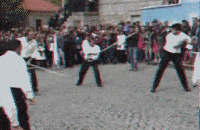
A shorter staff is however, easier to maneuver, because of its lightness, it would however not be chosen, because a longer staff, about the height of a man would really give a distance advantage.
However, up to a limit, because a much longer staff starts to be much harder to maneuver, and the same technique stops to be ineffective in use. This limit is caused not only by the limit of strength of the person using it, but also by the weight of the fencer, because even when used correctly and with the full allocation of body weight, at some point, a much longer staff becomes slower in rotation, and would have to be used in other ways that would not grant the same advantages in speed and power generation than the traditional length employs, so that extra length would not grand advantages, and this is the natural limit to the staff’s upper length in this context.
-Frederico Martins
Mercado da Corujeira
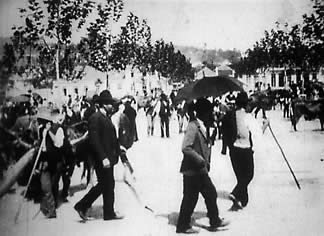
—0 sr. governador civil prohibiu o desafio do jogo do pau no mercado da Corujeira.
“Diario Ilustrado” – Domingo, 29 de Maio de 1892
EN: Mercado da Corujeira
Occasional news: “The Civil Governor prohibited the jogo do pau challenge in the Corujeira Market” – Sunday, 29 of May, 1892
note: Photo is a frame from the “Corujeira cattle Market” filmed by Aurélio Paz dos Reis in 1896. The Film maker made a jogo do pau video in the same year, that is unfortunately probably lost.
Artigo sobre o Jogo do pau na Atlantis, Revista de bordo da TAP- 1986
Jogo do pau cover and article in Portuguese and English on TAP‘s in-flight magazine from 1986
Jogo do pau in Gothenburg
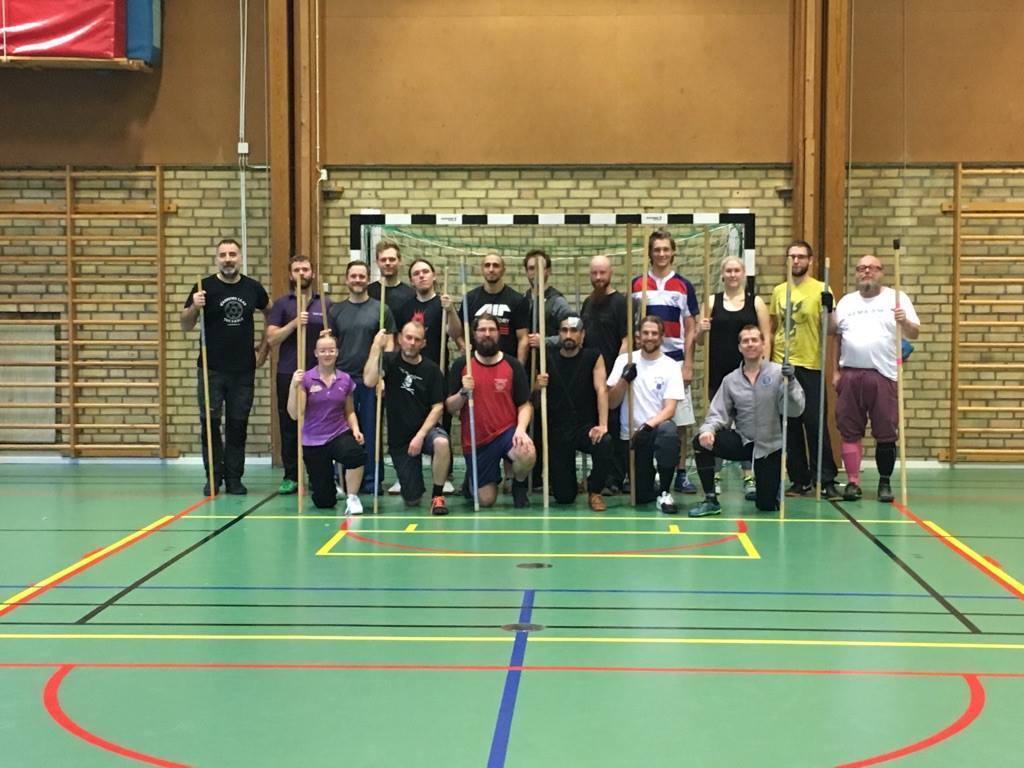
Picture taken on the first gathering for the practices of Jogo do Pau de Cepaes, October 23rd in Gothenburg.
Among us where representatives from several fighting arts and schools and it was the first among many coming gatherings to keep one of the few existing european martial arts traditions alive.
“…But lets work from the thesis that Mestre Avelino said that night on the parkinglot, or maybe how I understood him when I was drunk as fuckshit:
`The duell only happens when the group has failed its main job, namely to work as a group.`
From this we can read that the true martiality in JdP is that every single Jugador knows how to work in a group FIRST and that the duell, the Contra-jogo, is a last resort.
We can also read from this that every Jugador knows how to handle and recognize impossible odds, and the mercilessness in being completely left alone in the role as Batedor. Because the Picadores will not challenge you one by one and risk themselves, they will stress you as group and force you to move so that you get tired and must give up.
And from that we learn that no man will risk his own life if it is possible to drain his enemy of stamina and then capture or kill him with less effort.
It is a lesson that needs to be learned, that you are doomed without your group.
Therefore this is true when we train:
We are friends. But we are not friends.”
-Jogo do Pau de Cepaes, Nicolas Gallardo
Göteborgs Frifäktargille
Halmstad HFS
Malmö HFS
Mestre António Nunes Caçador
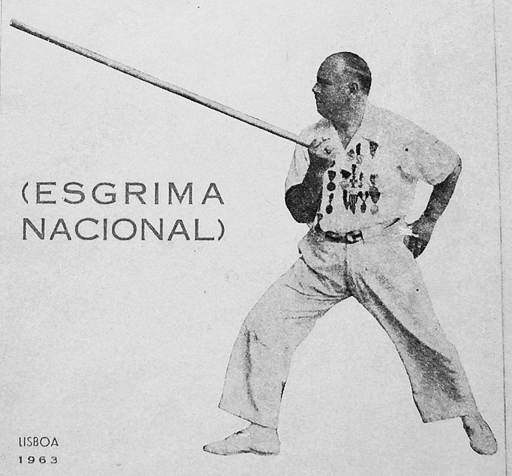
Scroll down to Read in English
Artigo do jornal «Novidades»
por Sebastião Duarte da Mota Cerveira.
Dos mestres do jogo do pau que actualmente têm escola em Lisboa é de toda a justiça colocarmos num lugar de destaque António Nunes Caçador, antigo professor do Grupo Desportivo da Companhia dos Tabacos e, presentemente ajudante do mestre Domingos Miguel, no Ateneu Comercial de Lisboa.
Caçador principiou a jogar o pau em 1922 no Ateneu Comercial e o seu primeiro mestre foi Jorge de Sousa que, nos grandes tempos da esgrima lusitana, tinha sido discípulo do abalizado mestre Frederico Hopffer.
Depois de ter trabalhado durante alguns anos com aquele professor, fez-se discípulo de Domingos Miguel, jogador de combate, um dos maiores de todos os tempos, uma autêntica maravilha na arte de manejar uma vara de lodão!
António Nunes Caçador, elemento de primeira ordem no jogo do pau, exímio em «cortes» e maravilhoso em «passagens» é hoje sem dúvida, um dos mais completos jogadores de Lisboa, inúmeras vezes, em lutas emocionantes que deram brado pelo ardor com que foram disputadas, tem provado que não conhece o medo e que a sua vara está sempre pronta a cruzar se com a de qualquer adversário por muito que seja superior a sua classe!
Ultimamente, no Ateneu, quando este clube foi visitado por uns jogadores da província que aí se exibiram sustentou uma dura batalha com o mestre dos aludidos jogadores batendo-se com toda a galhardia marcando nítida superioridade sobre o seu antagonista e elevando ao máximo a escola de Lisboa que ele, nessa luta emocionante representava!
E o jogo que travou com o aludido mestre da província foi coisa que ainda não se tinha visto no Ateneu e, pela violência com que foi disputado, fiz lembrar os grandes jogos dos tempos em que a esgrima do pau era cultivada nos quintais de Lisboa!
Grande tem sido a propaganda que António Nunes Caçador tem feito da esgrima do pau: já jogou inúmeras vezes no Coliseu dos Recreios em Lisboa, em Santarém, em Alhandra, Caldas da Rainha, Montijo, Almada, Moita, Leiria, Coruche, Barquinha, e em muitas outras localidades e também no Pavilhão dos Desportos.
Nunes Caçador é autor de um interessante e útil tratado sobre esgrima do pau e que foi publicado em 1943 livro escrito em linguagem clara e simples e ao alcance de todas as inteligências, é de grande utilidade para os amadores do viril desporto! Nada falta nessa obra, e o autor mostra claramente o conhecimento que possui do assunto pois trata, magistralmente em todas as suas minúcias a esgrima lusitana.
António Nunes Caçador que está, presentemente na força da vida, é pois, um grande jogador e um mestre da mais sólida competência e as suas exibições sempre aplaudidas, fazem recordar os velhos tempos da esgrima portuguesa, os tempos dos jogos nos quintais de Lisboa, ocultos pelas trevas dos anos, mas sempre lembrados com saudade pelos amadores do viril desporto que é o jogo do pau, cultivado com toda a mestria na linda terra portuguesa.
em “Jogo do pau (Esgrima Nacional)” António Nunes Caçador, 1963.
en: Master António Nunes Caçador
Article from newspaper “Novidades” by Sebastião Duarte da Mota Cerveira. (around the 50s?)
Of all the masters currently in the Lisbon school, it is fair to highlight António Nunes Caçador, old professor of “Grupo Desportiva da Companhia dos Tabacos” and presently, as assistant master to Domingos Miguel, in “Ateneu Comercial de Lisboa”.
Caçador started staff fencing in 1922, at “Ateneu Comercial de Lisboa” and his first master was Jorge de Sousa, that in the high time of the lusitanian fencing (late 19th and early 20th century in Lisbon), had been a disciple of master Frederico Hopffer.
After some years of training with master Jorge de Sousa, he became a student of Domingos Miguel, a more combat oriented fencer, and one of the greatest of his time, a true wonder in the art of maneuvering a lote staff!
António Nunes Caçador, element of the first order in jogo do pau, was expert in «cortes» (evasion counter attacks) and «passages» and is today without a doubt, one of the most compleat fencers in Lisbon. For inumerous times had exciting fights that were hailed by the audience for the fervor with wich they were disputed. He prooved to be fearless and his staff is always ready to cross with any opponents, no matter how great is their level!
Lately, in Ateneu, when this club was visited by some fencers from the province, he had a great battle with the master of the mentioned fencers, fighting gallantly, and marking clear superiority over his antagonist, he elevated the name of his school, that he represented in that thrilling fight.
It was a fight like it is rarelly seen in Ateneu, due to the level of violence at wich it was disputed, remembering the best times of staff fencing in Lisbon.
Great has been the propagand that António Nunes Caçador has made of the art of staff fencing, he fenced many times in “Coliseu dos Recreios”, in Lisbon, Santarém, Alhandra, Caldas da Rainha, Montijo, Almada, Moita, Leiria, Coruche, Barquinha and many other places, and also in “Pavilhão dos Desportos”.
Nunes Caçador, is an author of an interesting staff fencing manual, that was published in 1943, book written in clear and simple language, at a reach of everyone, and of great utility for all lovers of this manly sport! Nothing is lacking in this work, and the author clearly shows his knoledge of the subject and all the minutiae of the lusitanian fencing.
António Nunes Caçador is now in the hight of his life, he is a great fencer and a master of great competence, his exhibitions are always hailed, and make us remember the old times of the Portuguese fencing, occluded in the shades of time, but always remembered by the lovers of this manly sport that is staff fencing, nurtured with great mastery in the beautiful Portuguese lands.
Serafim Curado Borges da Gama
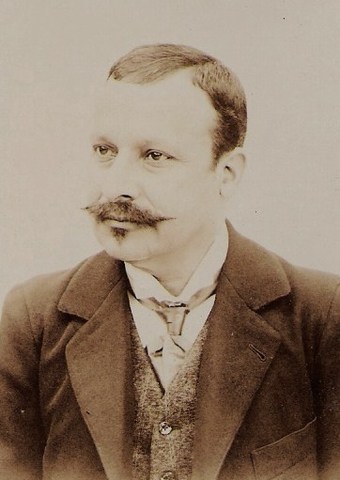
Serafim Curado da Gama, o seu grande sonho foi fundar a primeira farmácia da terra (na altura chamava-se botica), num tempo em que ocorriam dezenas de mortes por ano, devido à total ausência de cuidados médicos (era o apogeu do então fatídico jogo do pau). A farmácia nasceu em 1898, quando os medicamentos eram misturas feitas em almofarizes de pedra. Até à pouco tempo, manteve o seu nome. Diz-se que Serafim Curado da Gama salvou dezenas de vidas.
http://geneall.net/pt/forum/532/familias-de-alvaiazere-e-pussos/#a222875
https://www.geni.com/people/Serafim-Curado-Borges-da-Gama/6000000002805589093
EN: Serafim Curado da Gama had the dream of opening the first pharmacy in his village, because of the large number of deaths due to the lack of any medical care in the region, in a time that the fatidical jogo do pau was very common. He opens the pharmacy in 1989, and is said to have saved many lifes.
Romarias em tempo de guerra.
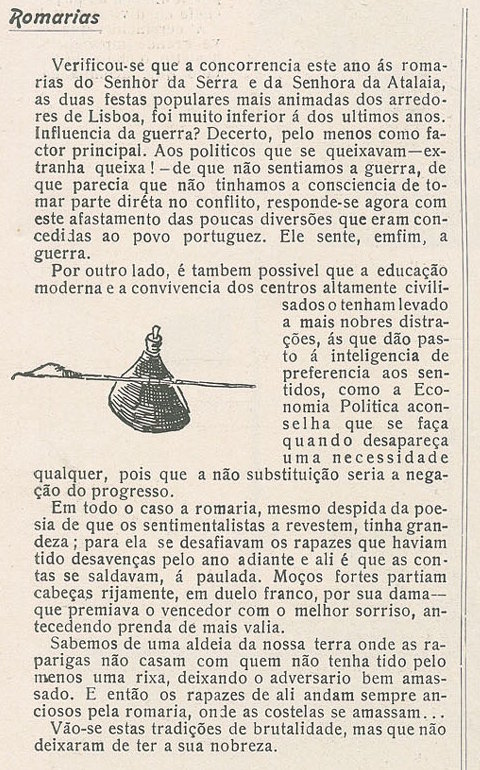 Scroll down for English translation: Wartime Festivals
Scroll down for English translation: Wartime Festivals
Verificou-se que a concorrência este ano ás romarias do Senhor da Serra e da Senhora da Atalaia, as duas festas populares mais animadas dos arredores de Lisboa, foi muito inferior á dos últimos anos. Influencia da guerra? Decerto, pelo menos como factor principal. Aos políticos que se queixavam -estranha queixa! – de que não sentíamos a guerra, de que parecia que não tínhamos a consc1enc1a de tomar parte directa no conflito, responde-se agora com este afastamento das poucas diversões que eram concebidas ao povo português. Ele sente, enfim, a guerra.
Em todo o caso a romaria, mesmo despida da poesia de que os sentimentalistas a revestem, tinha grandeza; para ela se desafiavam os rapazes que haviam tido desavenças pelo ano adiante e ai é que as contas se saldavam, à paulada. Moços fortes partiam cabeças rijamente, em duelo franco, por sua dama, que premiava o vencedor com o melhor sorriso, antecedendo prenda de mais valia.
Sabemos de uma aldeia da nossa terra onde as raparigas não casam com quem não tenha tido pelo menos uma rixa, deixando o adversário bem amassado. E então os rapazes de ali andam sempre ansiosos pela romaria, onde as costelas se amassam… Vão-se estas tradições de brutalidade, mas que não deixaram de ter a sua nobreza.
“ilustração Portuguesa” Nº602 – 3 de Setembro de 1917
Wartime festivals
There was a small afflux at the two most popular festivals near Lisbon, Senhor da Serra and Nossa Senhora da Atalaia had much less people that in the last years, influence of the war? For sure, as a main factor. For the politicians that complained – and what a weird complain – that we didn’t feel the war, and didn’t have conscience that we were taking part of the conflict, the answer is now this absence from the very few occasions the Portuguese people have for themselves to enjoy. The people finally feel the war.
Even so, the festival had a grandness in itself, in it the boys challenged each other solving the rivalries accumulated along the year, and the the problems were settled, with staff fights. Young and strong boys breaking each other’s heads fiercely, in a franc duel, because of a lady, that would reward the winner with her best smile, anticipating a most valuable gift.
We know of a village where the girls don’t marry a man that had not made it into at least a brawl, leaving his opponent smashed. So the boys of the region are always anxious for the festivals, where ribs get broken… This brutalities are going away now, but they still have their nobility.
in “ilustração Portuguesa” Nº602 – 3 de Setembro de 1917
Review of Luis Preto’s jogo do pau and fencing DVD’s
[youtube https://www.youtube.com/watch?v=IqOpus788YU&w=560&h=315]
Reviews of Luis Preto’s most recent DVDs:
http://hemareviews.blogspot.pt/2015/06/luis-pretos-combat-tactics-dvd-review.html
http://hemareviews.blogspot.pt/2015/08/review-luis-pretos-from-battlefields-to.html


